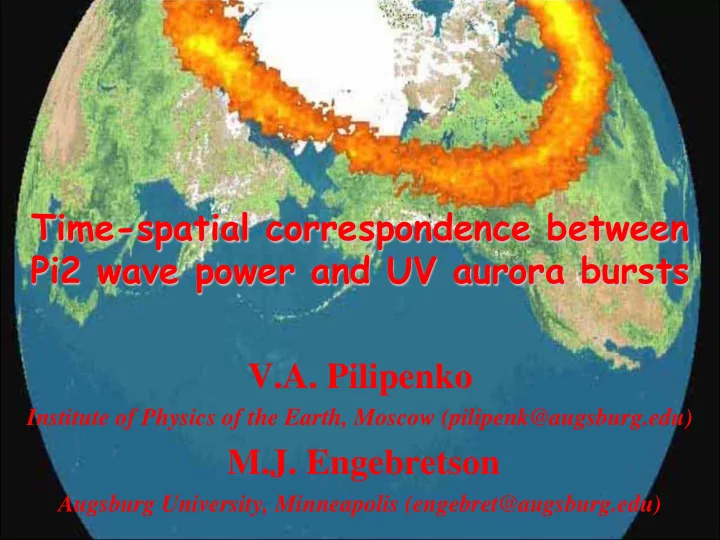

Time-spatial correspondence between Pi2 wave power and UV aurora bursts V.A. Pilipenko Institute of Physics of the Earth, Moscow (pilipenk@augsburg.edu) M.J. Engebretson Augsburg University, Minneapolis (engebret@augsburg.edu)
Abstract Although the Pi2 signals (T~1-2 min) are a generally recognized indicator of the onset of the substorm explosive phase, the mechanism of their excitation and the propagation channel from the substorm "epicenter“ in the magnetotail to the Earth's surface has not been finally clarified. We have superimposed synchronous UV images of aurora from the POLAR and IMAGE satellites, the positions of the ionospheric electrojet and spectral power of geomagnetic signals in the Pi2 band. The latitude distribution of the Pi2 power and the position of the ionospheric electrojet were determined from the data of the MACCS-CARISMA-MEASURE networks. The development of the substorm manifests itself as a series of successive activations, each of which is accompanied by an increase in auroral luminosity and ionospheric currents, and a burst of Pi2 pulsations. The "epicenters" of each activation are shifted abruptly poleward and westward. It is found that the latitude of Pi2 pulsations is mainly confined to the poleward slope of the auroral oval. The results of a detailed analysis of individual events are confirmed by statistical latitudinal distributions of the intensity of auroral UV emission and Pi2 power.
2001 02/01 event (day 032) Several auroral activations occur as can be seen from the IMAGE auroral images: ~0424 UT slightly eastward from the 330 o profile ~0442 UT when the auroral intensification region extended till 300 o profile The snap-shots indicates a general tendency of westward and poleward leap of each subsequent activation as compared with a previous one. The maximal Pi2 power, as characterized by the color-coded station circles, is observed near the poleward boundary of auroral brightness
UV intensity Pi2 power X & Z components Each auroral activation (characterized by the spatially-integrated UV intensity) is accompanied by magnetic bay, progressively shifted to higher latitudes. Onset of each magnetic bay is marked by Pi2 burst. No systematic change of frequency of Pi2 bursts (~10 mHz) at different latitudes is seen upon the substorm evolution
Pi2 signatures at high & mid latitudes High latitudes Middle latitudes Pi2 signature is most evident at middle latitude. At high latitudes, one can seen not an isolated Pi2 wave train, but rather an onset of irregular pulsation activity in the Pi2 band. During the second activation, on ~0440 UT, a burst of irregular pulsations in the Pi2 band is observed at high latitudes, but no response can be seen at middle/low latitudes.
Latitudinal distribution of the OVATION precipitation, UV intensity, magnetic field disturbance, and Pi2 power OVATION UV intensity AEJ Pi2 power The position of the westward auroral electrojet is always shifted to the poleward edge of the auroral oval, and it leaps together with the auroral spot during each activation. Pi2 spectral power is also shifted poleward in respect to the auroral luminosity peak.
Statistical normalized distributions UV of the UV intensity and Pi2 power Statistical analysis of 31 Pi2 events from POLAR UVI (blue) and IMAGE WIC (red): All the latitudinal distributions of UV intensity are summed up, normalized to the maximal value, and 70 o . shifted to the reference latitude The corresponding normalized latitudinal distributions of Pi2 power have been shifted in latitude accordingly. Pi2 The comparison of these distributions shows that Pi2 power is predominantly located either under the maximum of the auroral emission, or is displaced to the poleward slope of the auroral oval.
Snap-shots of UVI/WIC images and ground magnetometer data confirm that a substorm develops as a series of “detonations”, accompanied by the enhancement of auroral luminosity, intensification of the auroral electrojet, and burst of Pi2 wave power. Rather surprisingly, the meridional locations of the Pi2 power enhancement tend to be associated with the poleward edge of auroral activation region, though a substorm onset is commonly marked by brightening of the most equatorward auroral arc. Impulsive processes in the magnetotail are accompanied by excitation of MHD modes propagating Earthward via different channels. The found association of Pi2 power with the poleward edge of the auroral oval favors the mechanism of compressional mode conversion at the interface plasmasheet/lobe into Alfven waves (A).
Recommend
More recommend